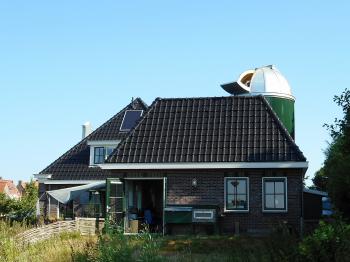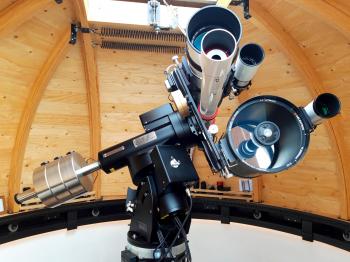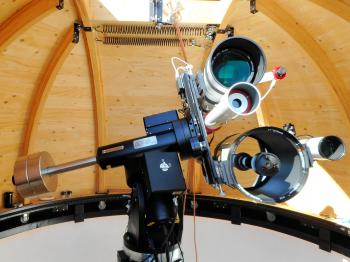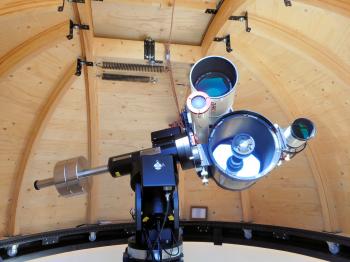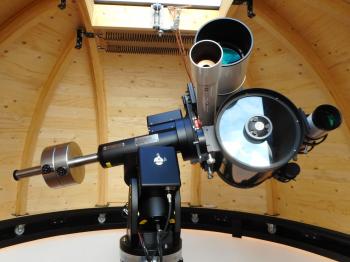AstronomySeventeen years of research on nautical instruments produced various sidelines that were not covered in my PhD thesis. One that fascinated me most was Galileo Galilei's early seventeenth century proposal for longitude finding at sea. Galilei had discovered the first four moons of Jupiter (Io, Europa, Ganymede, and Callisto) in 1610 (see figure 1, for more pictures see the astrophotography page) and soon realised that they formed a heavenly clock that could potentially be used as a reference clock in the determination of longitude by comparing tabulated times of the moments its moons touched the Jovian limb with times from onboard observations. Although a valid method, the success of it depended on the quality of the instruments and the skills of the observer. In my PhD thesis I have shown that observational skills vary between observers due to difference in human visual perception and that in order to become a qualified observer at least some 500 observations are needed. In addition being on board a moving vessel would not have been beneficial to the results achieved with Galilei's method. Having researched human perception, using the nautical instruments I created through the years, I wondered what kind of accuracy in longitude finding could be achieved using Galilei's method and especially what the differences between two observers would be. For this I decided to build an observatory on top of our library (see figure 2). In it the following instruments are currently installed (see figure 3):
September 2021Another two additions arrived: a Solar Scintillation Seeing Monitor (SSSM, the small white disc-faced sensor) and a SkyWatcher Esprit 80ED were added to the rig. The SSSM provides an objective value for the seeing and allows to trigger solar imaging sessions automatically based on the seeing conditions. The Esprit 80ED was added for wide-field imaging and to serve as a guide-scope when needed. The extra instruments required an addition counterweight, making the total of counterweights now 60kg (+15kg for the shaft). August 2020As I experienced drift in RA-direction and wanted to be sure the drift was not caused by the side-by-side plate, I installed a Baader 8" PlaneWave clamp and ditto side-by-side plate (20mm thick). This massive 11kg combination is a truly magnificent piece of machined aluminium and holds the scopes better than ever before and leaves more room for the scopes (and for your hands). Sadly enough it did not improve the drift, but it sure is a better side-by-side plate than I had before. Another advantage is that there is much more room for cables to be run from the DEC-axis through the clamp. This set is a recommendation for all GM3000HPS/GM4000HPS owners! June 2019I decided to part with the Celestron C11 XLT Carbon (see figure 7) and to swap it for a Celestron C11 XLT EdgeHD (see figure 5), which has a mirror-lock to minimise mirror-flop. As the XLT has considerable mirror-flop, it is difficult to keep it parallel to the Esprit 150ED. Befriended amateur-astronomer Rob Musquetier wanted to sell his C11 EdgeHD as he is only doing astrophotography using APOs and no longer had use for it. Our C11 XLT Carbon was acquired by the astronomical society AWSV Metius in Alkmaar and is installed in their observatory. The EdgeHD has been serviced and now produces great planetary and solar images. The GTT60 was added to the array in September 2018 (see figure 6). This scope consists of a plano-convex singlet objective lens and plano-concave singlet eyepieces. It represents a telescope from the early days of telescopic astronomy and serves as the main instrument for historic research. 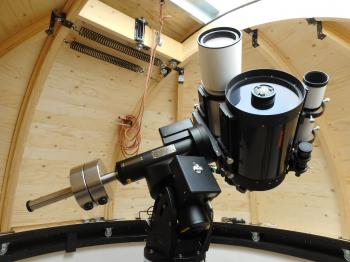 Figure 7: The set-up at InFINNity Deck when it opened in May 2018 (left to right: Esprit 150ED, C11, Lunt). Local schools Next to my own research the observatory is made available to the local schools. In September 2018 eight students, in four groups, of high schools Jac. P. Thijsse College and Bonhoeffercollege have started their research. The following year five groups of two students did their research based on data acquired at of provided by InFINNity Deck. The topics of their research can be found at the education page. Of course the observatory is also used for visual observing and for astrophotography. Sky conditions and astronomical twilightFor the sky conditions and astronomical twilight at InFINNity Deck see the Astrophotography section. If you have any questions and/or remarks please let me know. |
InFINNity Deck... Astrophotography... Astro-Software... Astro Reach-out... Equipment... White papers...


